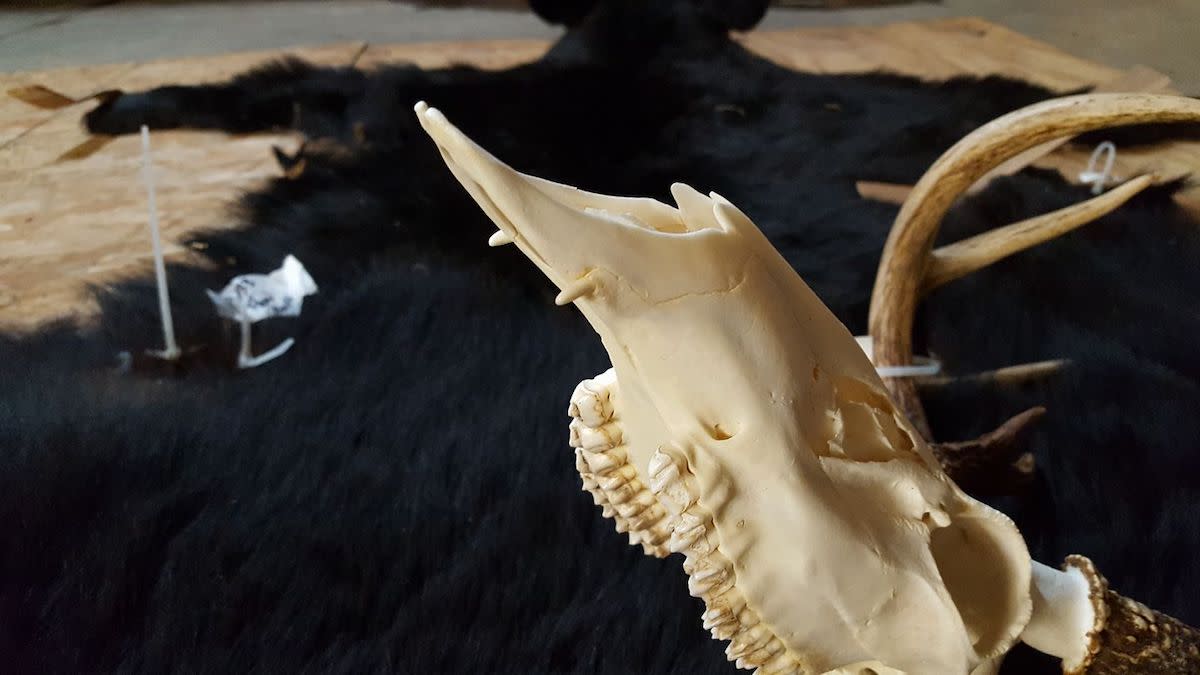
Vampire deer sound like something out of a bad horror flick. But some small cervid species primarily found in Asia sport curved tusks, or fangs, measuring 2 to 3 inches on top of their petite frames. These vampire deer, such as the Chinese water deer and Siberian musk deer, don’t grow antlers—or suck blood—but use their giant canines to intimidate and spar with other bucks.
While you’ll only find these Dracula-esque fangs on a few species outside the United States, some whitetails bear small fangs that are typically only visible once the skull’s been cleaned. These critters have also been dubbed “vampire deer.”
Cervids with Upper Canines?
These small, peg-like teeth measure just ½ to ¾ of an inch long no matter the deer’s age, and most don’t even break through the gum line—which is why taxidermists preparing European mounts see them most often. Growing from a small pocket in the bone, they fall about halfway between the rest of the teeth and the end of the upper jaw. While most fanged whitetails have a pair of these upper canines, some only have one on a single side.
Researchers believe ancient ancestors of the whitetail—much like musk and water deer—had sharp, long, curved tusks they used for survival, possibly even eating meat. But eventually these upper canines regressed in most subspecies, and whitetails evolved antlers for protection and mating purposes instead.
Mammalogist Valerius Geist, author of Deer of the World: Their Evolution, Behavior, and Ecology theorized that the small black patches you see on either side below a whitetail’s mouth are where the full-size fangs of these ancestors extended. Geist believed the dark patches highlighted the bright fangs and never evolved away, unlike the teeth.
But some whitetails still experience a genetic throwback in the form of fangs.
Taxidermists and wildlife biologists have discovered these vestigial upper canines in both bucks and does. They appear to be more common in bucks, but that could have something to do with taxidermists not seeing that many does.
Even with more and more hunters now pulling lower jawbones to age their bucks, upper canines often go unseen unless the upper jaw is also cleaned. If you only opt for shoulder mounts, you could’ve unknowingly killed a fanged buck at some point.
Upper canines can skip a generation, so if you’re hunting the son of last year’s fangless buck, you could still end up with a vampire whitetail.
While most reports of “vampire deer” in North America are whitetails, Arizona Game and Fish Department wildlife science coordinator Jim Heffelfinger said in his book Deer of the Southwest that some mule deer possess these fangs as well. And coveted elk ivories are actually the modern wapiti’s upper canines left over from cervid ancestors.
A Rare Find
In an issue of Quality Whitetails, former QDMA president Brian Murphy explained just how uncommon these fangs are.
“Upper canines are a rare but documented phenomenon in whitetails, and researchers believe it is an evolutionary throwback to the ancestral form of the whitetail which occasionally surfaces today,” Murphy said. “While the exact prevalence of upper canines in whitetails is not known, it is believed to be well below 1%.”
Some researchers estimate only one in every 10,000 to 20,000 whitetails will have upper canines, and the stats seem to vary by region.
In a 1963 report on whitetail anomalies, Lawrence Ryel of the Michigan Department of Conservation—now the Department of Natural Resources—noted deer with upper canines were found from Saskatchewan through Central America, with increasing occurrence from north to south. Some states, including Wisconsin, reported zero examined deer with upper canines, while 4.2% of Florida’s small sampling had fangs.
Some taxidermists with decades in the business have never encountered a fanged whitetail, while others expect to handle one nearly every year.
For reference, you’re at least 10 times as likely to tag a multi-bearded tom, and you’re more than twice as likely to spot a piebald whitetail than you are to kill one with upper canines. So if you find a set of these fangs on your next whitetail, you’ve scored a rare trophy.
Feature image via Cary Bluff Taxidermy Facebook.





